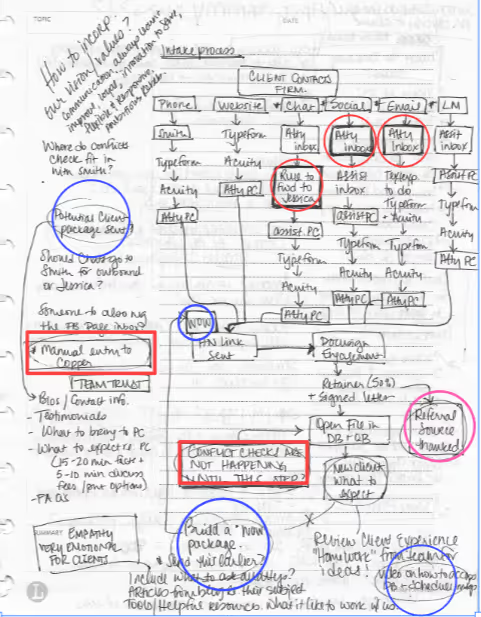How to Map Your New Client Intake
How to Map Your New Client Intake

This is a guest post by Justie Nicol, Founder of Nicol Gersch Petterson Law Firm.
Intake is often about your needs as an attorney and law firm owner, and sometimes less about the client. That’s not to say the client’s intake experience isn’t important. It is. But just as your relationship to a client must be a two-way street, designing your intake system is equally about your firm and what works for you.
To really dial in your intake process, the first conversation is about your firm's values:
- Are you going to take a shotgun approach (broad-based outreach to many candidates) or a rifle approach (targeted outreach to few candidates)?
- Are you looking to attract the highest paying folks or provide access to justice at a reduced price?
- Are you the go-to expert in an area of law or a practitioner who delivers excellent customer service?
All of these things will have a different process for intake.
How might that work? Let’s jump into how intake works for me.
Map Your Intake
If you already know your intake process pretty well, you may prefer to troubleshoot specific portions to make it flow even better. If not, though, it’s best to really dive into how your intake process works.
Mapping your intake process is probably the single most important thing you can do, especially in terms of understanding how your business works — and see yourself as a new client does. When you work in a system constantly, you will tend to underrate its flaws, since you’ve grown used to working around them. A new client may not feel that way.
To map your intake you really need to know where your clients are finding you (social media, website, in person, referrals, all of the above, etc.). This is one area where it also helps NOT to use technology.
I start with a large white board, but you can use a series of sticky notes or even just a good old-fashioned pen and paper.
You'll also need to think about what your firm is — and what you want it to be.
What is Your Mission?
Our mission is to serve cost-conscious criminal defense clients looking for quality legal help using technology to keep overhead low and profit high. We treat every person like a VIP.
Given our values, it’s natural that our intake process is full of technology. It serves as a pre-screen for us to be able to help you. Don’t have an email address? Not comfortable communicating electronically? It’s possible we’re not the right attorney for you. For us, it’s all about fit.
Notice the first sentence of the last paragraph: We’re only looking for criminal clients. Naturally, we get asked to consult on a number of different types of law. But we’ve built in automated referrals to other attorneys in our network rather than trying to be a general practice.
Thanks to technology, we are fully virtual and as such have little to no overhead. This is a key component of our business model. So, our intake allows for people to have Zoom conferences instead of phone consults.
Where Does Your Intake Go From Here?
Next, ask yourself: What are you looking to improve in your intake right now? In the medium-term? The long-term?
Some things are easy fixes. One of the best things I did early on was to link my calendar to our calendaring system (like Acuity Scheduling or Calendly) for initial consults. Shortly after I fully committed to e-signatures for all documents. From engagement letters to bond acknowledgments and other pleadings, it’s all e-sign all the time for us. I also outsourced my call answering to Smith.ai, so my clients would reach a human voice even when I wasn’t available. These changes were quick and relatively painless.
Other things take longer to implement. We built “wow” packages for our clients into different stages. These are pdf’s that go above and beyond to explain the process and how our team works. That took time to write, design, stage, and finally to build an automated roll-out. I made a conscious decision to take our time and get that right.
Still other fixes require learning new technology. Don’t go down the tech rabbit hole unless you’ve got ample time to do so — it’s fascinating, but you have to keep money coming in through casework, too. It will also result in lots of trial and error. Don’t be afraid! It’s ok to fail. In fact, I learn more from what I break than I do from what works smoothly, and nothing ever runs perfectly in the first iteration.
Know Your Clients’ Expectations
As you dig into who, what, where, how, and when, you should also realize that what attorneys think clients want rarely, if ever, matches with what they actually do. Have you asked current and past clients what they liked about the hiring process and what they didn’t like? The results might blow your mind.
Something like 82% of consumers expect an immediate response when inquiring about services, and 67% of law firm clients said their decision to hire was most influenced by the attorney’s initial responsiveness to their first email or call.
Nevertheless, about 40% of lawyers let new client calls go to voicemail, and 78% of lawyers never respond to the potential client’s attempt to contact them, according to Clio Trends.
Get Some Basic Info
You’ll need some basic information to follow up with prospects. Typeform is a great, simple way to capture it. Whatever intake system you use, you should be capturing data. Name, email, cell phone, address, other party’s name(s) for conflict checks, and a description of what kind of help they need.
For bonus points, get data about how they found you, what jurisdiction / geographic area their case is, when their next court date or other critical deadline is, and consider putting a disclaimer in (we don’t represent you… yet!).
No One Right Answer
There are always multiple paths by which a prospect can find you. But consistency is key once they walk through the door. Consider that approximately 6 “touches” are required before most consumers make their buying decision. If nothing else, you should be thanking them after each call or email.
Make it easy to find you, easy to hire you, and easy to pay you.
Start Simple and Build as You Grow
An intake process doesn’t have to be complicated. After you’ve mapped the intake process out, you can add more detail for different methods of contacting you, human touch points that can be eliminated with automation, and even where wow packages will come in. In any case, though, you should have a system in place for following up with prospects regularly. For that, I recommend a CRM like Clio Grow. It’s been crucial to fine tuning our sales process and having 4 people working the sales pipeline at any given time has been amazing.
Most of our clients call to contact us. So our simplified intake for calls looks something like this:

Apply Your Map to Real Life
After you’ve mapped out a simple process, think about how it translates to real life. Look really hard at your map and ask yourself:
- Can a machine or tool do one or more of these steps better? Should a machine do it?
- Should an attorney be involved vs. a staff member or outsourced contractor? Is this the highest and best use of your time? (hint: fielding sales calls and spam is not)
- Can this meeting be an email; can this phone call be a handout; can we automate delivery?
After a while your intake process will work like a well-oiled machine. But there’s always room for improvement. Are you thanking your referral sources? Are you delivering on your promises? Are there pain points?
Now, several years later, our intake process is a bit more complicated:
%2520(1).avif)
The blue circles are wow possibilities that can be automated and delivered to the client seamlessly. The red is a pain point to be addressed. And the pink is something we just need to do better at…

Not only will using technology and a streamlined intake process help your staff and your own mental health, but it will also help your bottom line. I’m a firm believer in delivering legal help to people who need it, and keeping our costs down is one of the ways that we do that. One colleague of mine recently calculated the savings in dollars and hours to be $4,366 per month and 12.7 hours per month.
That is a huge cost savings! Just think of how many more clients you can sign and how many more people you can help with that much time off your plate.
Take the faster path to growth. Get Smith.ai today.
Key Areas to Explore
Technical Implementation Terms
Voice user interface (VUl) design
Speech recognition integration
Text-to-speech optimization
API connectivity and webhooks
Real-time data synchronization

Your submission has been received!









.avif)




.svg)



